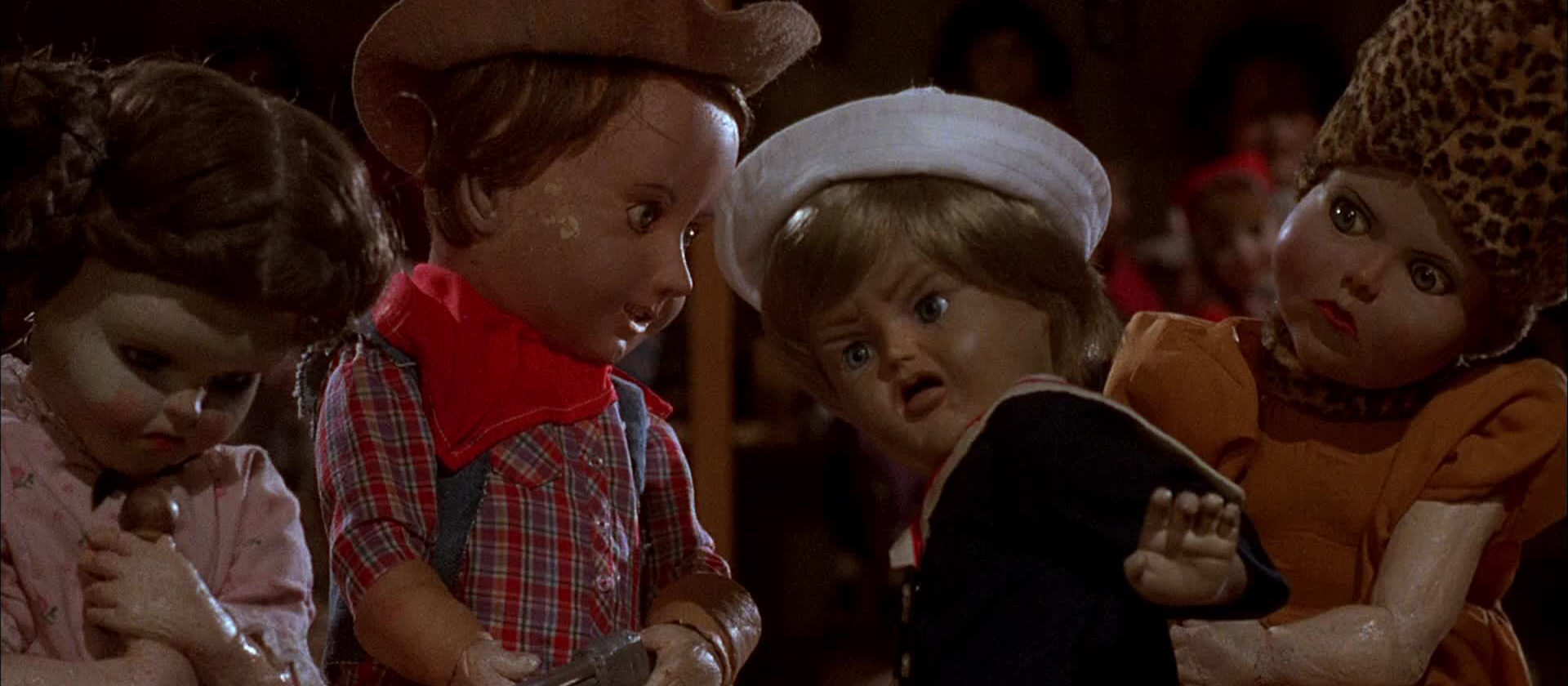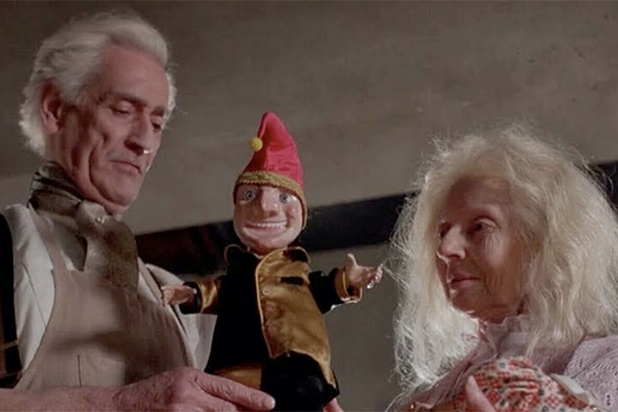

“Who’s going to arrest us out here? Count Dracula?”
I understand fear of clowns. Clowns are real human beings. To get all painted up and in costume on the regular, you must be at least a little bit off. Plus I’ve read IT. But fear of dolls doesn’t make sense to me because dolls are inanimate. Or at least they’re supposed to be. Stuart Gordon’s Dolls takes the central conceit of Toy Story—that our childhood toys were having fun behind our backs—and turns it into a live-action horror movie complete with a gothic mansion, a thunderstorm, clueless travelers, winding corridors, dusty attics, and a creepy old couple that act as hosts. It’s an admittedly silly premise, but one that Gordon wisely chooses to approach playfully. There’s a light message about clinging to your inner child, good practical effects, and some surprisingly solid stop-motion animation. It never asks to be taken seriously—would prefer not to be, in fact—but it does pack some serious gore and a decently unsettling ending.
While en route to their vacation spot, David (Ian Patrick Williams), his wife Rosemary (Carolyn Purdy Gordon), and his daughter Judy (Carrie Lorraine) get stuck in the mud on a remote back road. Fleeing from the oncoming rainstorm, they duck into the open basement of a stately mansion. Once discovered by the owners, Gabriel (Guy Rolfe) and Hilary Hartwicke (Hilary Mason), they are welcomed in to wait out the storm.
It turns out that Gabriel is a master toymaker, and the eldery couples’ abode is brimming with antique, hand-crafted dolls—every shelf, nook, bench, mantle and night stand. As soon as the visitors sit down to a warm dinner, another trio bursts into the mansion to escape the rain. Ralph (Stephen Lee) is accompanied by two hitchhiking punk chicks named Isabel (Bunty Bailey) and Enid (Cassie Stuart) that he picked up only a mile down the road. Each character has the basics of a personality, but the only ones that really matter are Judy and Ralph. Judy has a hyperactive imagination—for instance, when Rosemary tosses her teddy bear into the weeds she fantasizes that it grows to the size of grizzly and mauls her stepmother (a terrifically absurd moment)—which allows the other characters to dismiss her claims that “elves” have dragged Isabel away in the middle of the night. Ralph is the only adult character who still has an “inner child” and so manages to survive several close scrapes with the animated dolls by its perceived virtue.

That being the case, it is no surprise that everyone except Ralph and Judy wind up dead… or, even creepier, transformed into dolls. As Gabriel patiently explains to David as his body changes shape and he shrinks down into a facsimile of a doll he had recently destroyed with a sledgehammer, their mansion full of toys functions as a test for visitors—children and those who appreciate the joys of childhood are allowed to go free, while the bitter adults are transformed into dolls. And to be honest, David, Rosemary, Enid, and Isabel are such obnoxious, unpleasant characters that I was not sad to see them go. I know this was the intention, but it sucked any bit of fright out of those scenes. The practical effects work lends a veneer of believability to the proceedings, and the herky-jerky stop motion animation approximates what I’d imagine animated dolls on the attack would look like. Even the doll close-ups with their weirdly flexible facial muscles are effective. Gordon also has a lot of things take place creatively off camera, such as Isabel’s initial encounter with the little demons as they bash her head against the wall, swinging her by her limbs like a ramrod.
The best parts of the film, including the stop motion and gore, only really pick up about three-quarters of the way through the film. Until then, we’re kind of left hanging with really weak dialogue and hammy acting. I believe these features are intentional, but they only fly when other elements, such as gore, jump scares, creepy music, character development, etc. are there to balance things out. Instead, we are only treated with a few movements of dolls’ eyes and a music box that keeps turning itself on. There’s also some incredibly cheap-sounding music courtesy of the brilliantly named Fuzzbee Morse, which begins with some promise but then is downhill from there. The other area of letdown is the cast. The Hartwickes are acted with suitable creepiness, but everyone else is amateur at best, unfortunately including Lorraine who can be spotted taking directions from someone off-camera at several points. A large part of the acting issues stem from Ed Naha’s screenplay, which isn’t sure how to handle the central contrivance. Dolls lacks the black humor Gordon’s self-penned Re-Animator but has nothing to compensate in its absence. The others are all duds, with the possible exception of Stephen Lee in his man-child role. Maybe bad acting was part of the gag for this one and I just don’t get it?
I suppose that one could read Gabriel’s subversive presence as some kind of long form joke. Instead of a wise old man, he’s a deranged loony who punishes passersby far beyond what their crimes would suggest appropriate, only sparing children or those who embrace adolescence as a way of life. Further, if someone wanted to make the case that Gordon was using the first portion of the film to parody 1980s horror-lite cinema in order to lower the audience’s guard before a more gruesome finale, I think I could buy it. But I’m not going to spend the time and energy to do that. I could even entertain the idea that although this isn’t strictly a kids’ movie (I think it’s a good rule of thumb that movie’s in which threesomes are a topic of conversation shouldn’t be considered for kids) it presents a child’s point of view with utter sincerity.
Dolls is certainly a more elegant, refined, and less exploitative outing than Gordon’s first two features, but it is devoid of the energy that makes those two wild Lovecraft adaptations so much fun to watch. Whether the stellar effects and animation are worth wading through the subpar script and acting is debatable. At only an hour and seventeen minutes, it will be over before you can say the name of the score’s composer.